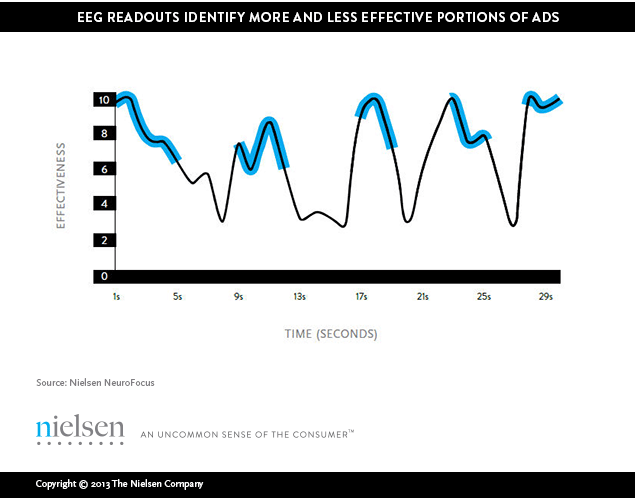By Randall Beard, Global Head, Advertiser Solutions for Nielsen
Often treated as an afterthought by marketers and agencies alike, the 15-second TV spot is usually just a cut down version of the 30-second spot, rarely copy tested, but assumed to be at least 50 percent as good as the :30 from which it’s derived.
But the truth is that most marketers have no idea how good, or bad, their :15s really are. It’s as if everyone just blindly assumes the best, without thinking about the worst. Fifteen-second ads adhere to the same basic principles of success as :30s, but just get much less attention.
An Improvement — Real Time :15 vs. :30 Optimization
Things have improved somewhat over the past few years. With the advent of real-time TV ad effectiveness measurement, marketers can now monitor the performance of their :30s and :15s on a weekly or bi-weekly basis, enabling them to understand relative differences in performance.
This allows you to see when your 15s perform well enough to warrant moving out of your :30s and into 100 percent focus on your :15s. But all of this is after the fact. What’s really needed is better :15 design beforehand. But how?
Consumer Neuroscience and Copy Testing
Consumer neuroscience has had any number of fits and starts over the past few years when applied to marketing. But one area where there has been substantial and undeniable progress is in the area of copy testing. The most advanced technique uses EEG measures of brain activity to understand how viewers are responding to advertising. This approach uses EEG to identify and capture responses to brain stimuli in fractions of a second.
In particular, EEG based copy testing can measure three things extremely well:
- Attention – When and how much viewer attention is paid to an ad. This is key to knowing if someone even notices or pays attention to your ad in the first place.
- Memory – Whether a viewer’s memory is activated in response to viewing an ad. Without memory, it’s unlikely that an ad will influence much future behavior.
- Emotion – To what degree a viewer is drawn to or pulls away from the ad stimulus. Attention and memory are important, but so is positive emotional attraction.
Taken together, these three measures are key to effective ads. They relate directly to whether someone pays attention to the ad, whether the ad is stored in long term memory, and whether the ad elicits a positive emotional response.
Importantly, EEG based copy testing measures viewer’s brain waves in milliseconds throughout the commercial. Typically, a viewer’s brain waves looks like a series of peaks and valleys as the viewer responds to different parts of the commercial. These peaks and valleys correspond to the parts of the commercial that are most and least effective as measured by attention, memory and emotion.
The Optimal :15 TV Spot
Back to the :30 vs. :15 conundrum: how do you design a better :15 TV spot? Well, it’s not as difficult as rocket science, but it’s essentially an exercise in brain wave assessment. Simply put, you cut out the ad’s “valleys” and keep the “peaks.”

Consumer neuroscience-based copy testing has advanced to the point where it can algorithmically eliminate the weakest portions of the :30 TV commercial while keeping the strongest ones for the new :15. This re-cut commercial is then edited by the agency creatives for story flow, continuity and visual seamlessness into a final spot.
The Consumer Neuroscience-Based :15 TV Commercial – How Good?
At this point, you might be asking: “but how good, really, are these cut down neuroscience based ads? It all sounds like a big black box.”
Based on Nielsen NeuroFocus testing of both original :30 TV spots and the EEG-optimized :15s, here’s what we see:
- ~90 percent of neuroscience optimized :15 ads test just as well as their :30 counterparts
- A significant number of optimized :15 ads actually test better than their :30 counterparts
So, the next time you see your ad agency, tell them that you have a “present” for them—consumer neuroscience-based :15s.
For additional information on consumer neuroscience-based advertising, read our What’s Next report on the subject.



